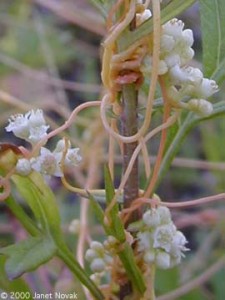
Last week, a vigilant HRWC volunteer, Nancy Sweet, alerted us to the possible presence of a new invasive plant for the area — Japanese dodder –– along Millers Creek. Luckily, the mysterious new plant turns out to be one of our native dodders, common dodder, Cuscuta gronovii. We forwarded Nancy’s astute observation to Jason Tallant, of Ann Arbor’s Natural Area Preservation, who tapped the expertise of the Director of the University of Michigan’s Herbarium. The dodder has probably persisted in this area for some time, and the growing conditions this season allowed for an abundance of growth.
Dodders are easily recognized by the yellow-orange stems that look like a tangle of thread. They have no leaves. Dodders are parasitic plants; they attach to a host plant and suck nutrients from it. Seeds sprout in the soil, but the plant loses all connection with the soil after it attaches to its host plant.
Volunteers with HRWC’s Bioreserve project have found common dodder in wetlands throughout the watershed this and last year.
We encourage anyone who notices any out of the ordinary plants or animals to give us or NAP a call or email.



